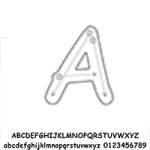
 |
Letter Draw |
This game has been specifically designed to help children with the written formation of letters of the alphabet and numbers 0 to 9.
On opening the game, a letter appears in the middle of the screen.
The bottom toolbar has both upper and lower case alphabets and number sequence 0 to 9.
The side toolbar has the following icons:
| Change the background colour | |
| Random button - get a new letter or number | |
| Sound/mute | |
| Exit |
The pointer appears as a pointing finger, but when over the character it becomes a coloured ball. It also changes to an arrow when over the bottom toolbar.
Children can click and drag the coloured ball over the character, following the dotted line. The numbers and arrows within the character outline suggest starting points and directions to follow.
New characters can be chosen by clicking on the letter/number sequences or on the random button.
Outcome 1: Children have a strong sense of identity
Outcome 4: Children are involved and confident learners
Outcome 5: Children are effective communicators
Identify letters of the alphabet - visual and auditory.
Identify numbers 0 to 9 - visual and auditory.
Recognise number and letter sequences.
Formation of letters of the alphabet.
Formation of numbers 0 to 9.
Recognise the difference in formation between upper and lower case letters.
Recognise the relationship between upper and lower case letters.
Mouse control: single click
Mouse control: click and drag.
This game is a fun, open-ended activity that children can explore freely. The letter and number names are said out loud so that they can associate the visual and verbal forms, thus aiding in the development of their early literacy and numeracy skills.
There is no right or wrong. The numbers and arrows within the character outline are there as a guide. Children are able to also have a draw outside the character outline, having fun with the changing colours and music. They can experiment with drawing slowly and fast, make a funny face or just enjoy having a scribble. Change the background to their favourite colour and practise drawing shapes around the character.
Teachers can also use this game in a directive way, challenging children to find particular numbers and letters in the number sequence and alphabet. Use the random button for a surprise letter.
Discuss the difference in use and formation between upper and lower case letters.
Ask children to repeat the name of the letter or number as it appears on the screen.
Ask them to name the character before they select it.
Talk about the sound that each letter makes and give examples of objects with that initial sound.
Young children are curious about the written word. They observe older children and adults writing and are eager to have a go. Children start to express themselves on paper initially with pictures and scribbles and then recognizable letters. Letters are associated firstly with their sounds and then to simple words. Their skill improves with practise, as does their ability to recognise and name individual letters and numbers. Praise and encouragement is vitally important as children progress through these stages, as well as ample opportunity to practise and access to materials needed.
Remember, learning is fun and exciting. Support and encourage children with every step along the lifelong path of discovery and wonderment.